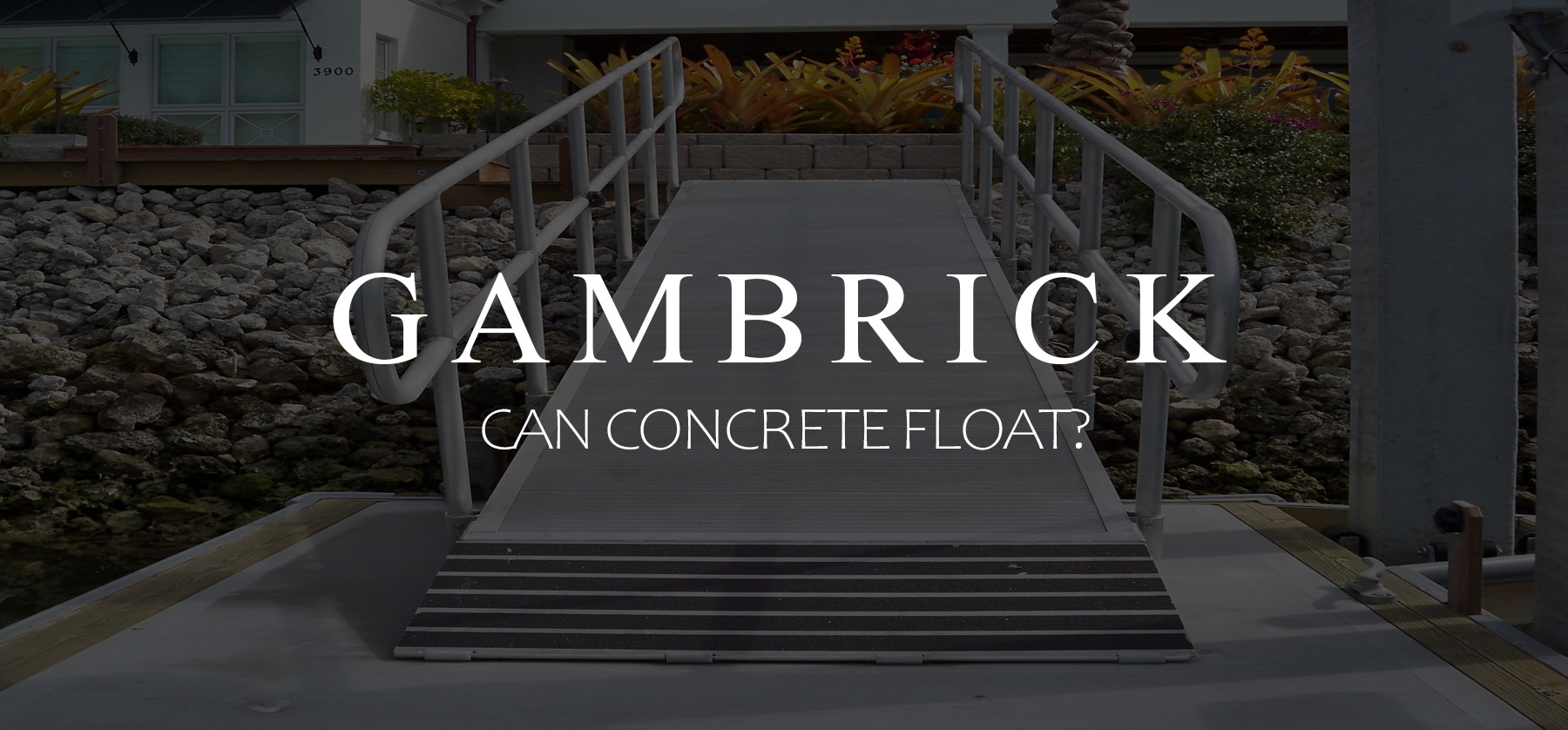
Can Concrete Float?
Concrete can float when the slab is designed and built correctly. Whether or not an object will float depends on its density, not what it’s made of. If concrete is shaped in the right way and light enough, it can float just like any other material. Any object, including concrete, will float if it’s less dense than the water it’s placed into. But an object will sink if it’s denser than the water. If it has an equal density, it will neither sink nor float. The density of water is generally 62.4 lbs/ft3 but that varies based on it’s salt content. The density of concrete can be altered by either changing it’s mass, it’s shape, or both. This is how concrete can float.
I’ve been a mason for over 25 years and can tell you firsthand that concrete can float. Concrete’s density can be altered by changing the volume it occupies. If you want concrete to float it’s very important to fill cracks with a crack filler immediately. If water penetrates into the slab it can sink the concrete.
A boat shaped or hollow object will displace a volume of water greater than the actual volume of solid material inside the boat. The object is considered to be “buoyant” when it floats due to low density.
Many floating walkways, barges, foundations are made from recycled concrete. By spreading out the concrete over a larger area, its density becomes less than the water’s and it floats.
Floating concrete structures are made solid, without any seams that can leak. This is done by building board forms or molds and pouring concrete inside.
Floating concrete is used in a variety of marine applications because it’s strong, durable, resistant to the elements, and light enough to float when designed properly.
Understanding Buoyancy
Most people believe concrete can’t float because of how heavy it is. But concrete is 3 times lighter than steel. And steel is used to build massive ships for cruises, military use and to carry cargo. In fact just about every large ship being used or built today is primarily made from steel. So how do they float?
Archimedes’ principle is the basic reason why these giant ships can float. Even if they’re made from concrete. Basically, if the weight of the fluid displaced by the object exceeds the weight of the object, then it floats. It’s a very simple principle to understand and it’s used to design the largest ships in the world.
Concrete war ships were built during World War I and World War II because of the steel shortage. But these ships never became popular because of how expensive and hard to build they are. Other materials are simply better for building a boat out of. However, many floating barges and platforms used today are actually made from concrete. Simple concrete slabs are easy and cheap to build. And they float.
Archimedes’ Principal
Any object, wholly or partially immersed in fluid, is buoyed up by a force equal to the weight of the fluid displaced by the object.
In other words, the force of buoyancy is equal to the weight of the fluid that was displaced by the object.This is why the objects shape is so important. If the concrete is heavy and dense, like a large chunk, it won’t float. But if it’s thin and spread across a large area, like a barge, then it can float. The weight has to be distributed across a large area to increase it’s buoyancy.
Whether concrete will sink or float in water depends on the density of the object and it’s shape. Extremely dense objects, such as steel or concrete will generally sink to the bottom unless it’s weight is spread out over a large enough area.
If the concrete’s density is lower than the total density of the water it’s placed in, it will float rather than sink. Most concrete will sink unless it’s designed specifically to float. Water naturally has a density of 62.4 lbs/ft3 and concrete typically has a density of about 150 lbs/ft3. However, you can change the density of concrete by adjusting it’s ingredients.
In order to float, concrete needs to be shaped like a boat or barge. It’s weight has to be spread out so that it displaces a volume of water that is equal to the weight of the concrete.
Floating Concrete Mixes
The concrete’s ingredients can be just as important as it’s shape. Typical concrete mixes are very heavy and dense because they’re designed to be used as a building material. Concrete has a lot of compressive strength which means it can hold a lot of weight before it cracks. This isn’t an attribute it needs when it has to float. Aggregates other than gravel and sand can be used to lighten the concrete.
The typical concrete mix designer for use as a building material is sand, aggregate stone and cement mixed with water. In place of gravel or sand, mix in fine glass beads. The beads are strong but much lighter than sand and stone. The glass beads are about 10% the density of water which helps the concrete float. The mix won’t have the same strength as standard concrete but it’ll be a lot lighter.
Although lighter concrete mixes float easier than denser ones. Traditional construction grade concrete made with sand, cement and aggregate can float. The same concrete batch in an Quikrete 80 lb bag that’s used to build walls and footings can also be shaped into a boat. It’s just a little bit harder to do.
Framing & Buoys Helps Concrete Float
In addition to altering the ingredients used in concrete to make it lighter, you can also put some design into the concrete slab itself. Manufacturers create floating barges and platforms for work around docks and bulkheads. These platforms have hollow tubes running inside the slab in place of rebar. In some cases they’re filled with light foam. This frame strengthens the slab and lightens it by creating lots of hollow space.
Another trick manufacturers use to float concrete is to attach buoys to the sides. These are essentially just like the tubes running inside the slab. Buoys on the sides help support the concrete slab and keep it from tipping. They’re light, strong and big which creates lots of buoyancy for the slab.
Floating Concrete Applications
Although we don’t see many floating boats, there are lots of companies making concrete barges and platforms that float. A large square or rectangular shape is fairly easy to make float because of how much water is displaces. All that surface area provides plenty of buoyancy.
Many concrete barge manufacturers will also place tubes filled with air or foam along side the concrete. These help stabilize the floating concrete slab and keep it from tipping.
Concrete makes a great floating surface for a walkway or work area because it’s porous, rough and non slip. It’s also dense and hard to crack which makes it great for work. Although I would highly recommend sealing any concrete used by salt water because salt weakens and degrades the concrete.
Concrete floating barges are cheaper than building them out of steel, aluminum, wood and most other materials. There are plenty of benefits to using concrete on the water. Although it doesn’t make the best boat, it does make a great platform.
Floating Concrete Pool Steps Don’t Float
Have you ever seen a modern style pool with concrete steps that appear to float? They’re not actually floating. These steps are supported by a support beneath it that ties into the pools foundation. These steps are just an illusion and are not to be confused with concrete that actually floats.
Summary: Can Concrete Float?
Concrete can float when the slab is designed and built correctly. Whether or not an object will float depends on its density, not what it’s made of. If concrete is shaped in the right way and light enough, it can float just like any other material. Any object, including concrete, will float if it’s less dense than the water it’s placed into. But an object will sink if it’s denser than the water. If it has an equal density, it will neither sink nor float. The density of water is generally 62.4 lbs/ft3 but that varies based on it’s salt content. The density of concrete can be altered by either changing it’s mass, it’s shape, or both. This is how concrete can float.
I’ve been a mason for over 25 years and can tell you firsthand that concrete can float. Concrete’s density can be altered by changing the volume it occupies. If you want concrete to float it’s very important to fill cracks with a crack filler immediately. If water penetrates into the slab it can sink the concrete.
A boat shaped or hollow object will displace a volume of water greater than the actual volume of solid material inside the boat. The object is considered to be “buoyant” when it floats due to low density.
Many floating walkways, barges, foundations are made from recycled concrete. By spreading out the concrete over a larger area, its density becomes less than the water’s and it floats.
Floating concrete structures are made solid, without any seams that can leak.
Floating concrete is used in a variety of marine applications because it’s strong, durable, resistant to the elements, and light enough to float when designed properly.
If you have any questions email or leave a comment below.

John Mazzuca | About | More Posts |
Custom Home Builder
John Mazzuca is a custom home designer and builder at Gambrick with over 25 years experience in the construction industry. John has designed, built and/or remodeled hundreds of homes, small buildings, and commercial projects. He writes about business, real estate, home building, and household electronics. His work has been featured in Fox Business, Better Homes & Garden, House Beautiful, and more.



















